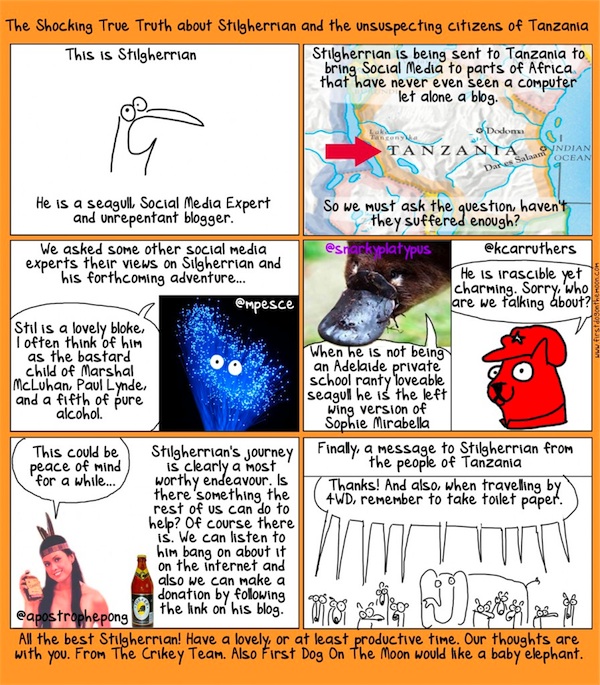I was on Radio 2SER’s program The Fourth Estate yesterday, talking about Iran and Twitter much as I did for Crikey on Thursday. By all means, listen to the podcast. You’re after the program for 19 June 2009, and it contains other good stuff too.
The Shocking True Truth…
It’s D-7 for Project TOTO, and I’m stressed beyond all belief. It’s now less than a week until I leave for Africa, and my Farewell Party is tomorrow. Meanwhile, the astoundingly clever First Dog on the Moon at Crikey has contributed a morale-building cartoon.
Click through for the full-sized image.
Yes, I still have thousands of things to do. But it’s Friday night and I’m exhausted, so I’ll tell you all about it in the morning. Probably.
Meanwhile, I’d live to know what you’re thinking about Project TOTO, so have a look at the previous posts and say stuff and ask questions and things.
And if you’re wondering who the people quoted are, try @mpesce, @snarkyplatypus, @kcarruthers and @apostrophepong. And also click through to ActionAid Australia for The Good Cause.
Psywar in Iran

“This is it. The big one. This is the first revolution that has been catapulted onto a global stage and transformed by social media,” says Clay Shirky, professor at New York University and author of the book Here Comes Everybody: The Power of Organizing Without Organizations. And what’s had the greatest impact? “It’s Twitter,†says Shirky.
So starts my piece in Crikey yesterday, We’re all wearing green for Iran now, apparently.
The article covers two main points.
One, this isn’t really the first time demonstrations have been organised or teargas reported via Twitter. Try Bangkok in October 2008. Try Chişinău in April 2009. And as Business Week pointed out, A Twitter revolution? Hardly.
Two, people are changing their avatars green to “support democracy in Iran” based on very little information. And as commenter Rena Zurawel claimed:
Whether it is a Rose Revolution in Georgia, or Orange Revolution in the Ukraine or a Green revolution in Iran — the source and inspiration is exactly the same: $70 million decided by the Congress to spend on so called “democratic changes in Iran”.
That last point intrigued me, so I poked around a bit.
I found this 2008 report from STRATFOR Global Intelligence: Geopolitical Diary: Iran, Psywar and the Hersh Article… which is reproduced in full over the jump.
Phonecasting in WordPress
While chatting with Jeff Waugh, we worked out a great way of blogging from remote Tanzania: podcasting by telephone! Here’s how.
Even if we’re not in one of the 70% of Tanzanian villages with mobile phone coverage, we’ll still have a satellite phone. We call into a voicemail service like mBox and just start talking. It then emails us the MP3 file of the recording.
WordPress already lets you blog by email, checking a standard POP3 mailbox and turning whatever it finds there into a blog post. Email subject becomes post title, email body becomes content. But it doesn’t support attachments. Yet.
Jeff reckons it’d be easy enough to see if the email contains an MP3 file and extract it. It could then be handed to, say, the PodPress plug-in, which in turn makes sure the MP3 file is properly connected to the blog post to work as a podcast. PodPress then automatically updates your podcast listing in iTunes and other directories.
As an added bonus, WordPress can automatically send a message to Twitter when a new episode goes online.
How do we avoid spam? Well, mBox uses Caller ID to make sure the email has a subject like:
mBox Voice message from NNNNNNNNNNN to MMMMMMMMMM
We can check the email headers to ensure they’re legitimately from mBox or whoever we use. And we can use the sender’s phone number to correctly assign the author, and the receiving phone number to, well, post into different categories or whatever.
So, to run through it again… I’m standing on the ferry to Zanzibar. I make a satellite phone call to describe the magnificent view. Five minutes later, that’s a podcast. And everybody gets notified via Twitter.
Of course there’s bound to be some potential for screwing this up, but whaddyareckon?
Links for 29 May 2009 through 08 June 2009
Stilgherrian’s links for 29 May 2009 through 08 June 2009. Yes, another delayed posting which will give you plenty of Queen’s Birthday holiday reading.
- How Twitter Will Change the Way We Live | TIME: Yes, TIME magazine’s cover story is about Twitter. It starts extremely badly: that clichéd, lazy trope about people tweeting what they had for breakfast. Despite that inexcusable slackness, it’s a useful addition to the cornucopia of Twitter-based articles.
- 10 Things I would do differently | Still A Newspaperman: Written with the benefit of hindsight, a former newspaper journalist considers how he’d have handled running a metropolitan newspaper. He’s spot on in many ways.
- Can the EU play Battleships? | Global Dashboard: Is it time for Europe, as a united entity, to develop a naval strategy? The article’s illustration is also a remarkable example of period gender stereotyping.
- How IT Can Save Africa | SAP Network Blogs: While clunkily-written, this piece outlines why getting decent IT to Africa isn’t a “waste”, but in fact a core element of getting rid of poverty.
- How Twitter’s Staff Uses Twitter (And Why It Could Cause Problems) | ReadWriteWeb: It turns out that the staff of Twitter don’t use it like “power users” like me use it. Could this affect the tool’s development?
- The oldest sculpture ever discovered is a 36,000 year old woman with really big breasts. Is anyone surprised? | 3quarksdaily: Dubbed the “Venus of Hohle Fels”, this 6cm tall sculpture us about 36,000 years old. And it has large breasts.
- Live Streaming Video From Livestream.com: The live video streaming service Mogulus has re-branded as Livestream. That should Hoover them into some generic wordspace, yeah. (Google it!)
- Spootnik: A tool to automatically synchronise information between 37signals’ Basecamp (which use extensively) and OmniFocus (which intend to use).
- Tom’splanner: Another software as a service start-up, this time about “creating and sharing project schedules”. Their website’s menu bar is the clichéd list of Home, tour, product Info, Pricing and — of course! — “Buzz”, so it must be good. Sigh.
- How Journalists Are Using Twitter in Australia | PBS: Julie Posetti’s rather reasonable article which responds to “the views of resistors and detractors” who argue that “Twitter isn’t journalism”. “Sound familiar to veterans of the great blogging vs journalism debate?” she asks. “Of course Twitter isn’t journalism, it’s a platform like radio or TV but with unfettered interactivity. However, the act of tweeting can be as journalistic as the act of headline writing. Similarly, the platform can be used for real-time reporting by professional journalists in a manner as kosher as a broadcast news live report.”
- Light Rail to Summer Hill | Metro Transport: The other Monday, yet another proposal for a new transport line in Sydney went to NSW state cabinet. This one involves extending the existing light rail line by 3.7km from Lilyfield to Summer Hill by converting the Rozelle freight line. It also has the advantage of running through the state seat of Balmain, where sitting Labour member Verity Firth runs the risk of losing to The Greens in the 2011 election.
20 years after Tianamen
It’s been 20 years since the Tiananmen Square massacre. Of the many things I’ve seen commemorating it, one of the most powerful was John Birmingham’s simple blog post of that day’s diplomatic messages from the US Embassy in Beijing.
Cable, From: Department of State, Wash DC, To: US Embassy Beijing, and All Diplomatic and Consular Posts, TFCHO1: SITREP 1, 1700 EDT (June 3, 1989)
PLA MOVES ON TIANANMEN, CASULATIES HIGH. EMBASSY BEIJING REPORTS THAT TROOPS USING AUTOMATIC WEAPONS ADVANCED IN TANKS, APCS AND TRUCKS FROM SEVERAL DIRECTIONS ON TIANANMEN SQUARE JUNE 3. THERE WAS CONSIDERABLE RESISTENCE BY DEMONSTRATORS, AND THE NUMBER OF CASUALTIES APPEARS HIGH.
Please read them all and, as I did, take a moment to reflect.
According to Wikipedia, “There were early reports of Chinese Red Cross sources giving a figure of 2,600 deaths, but the Chinese Red Cross has denied ever doing so. The official Chinese government figure is 241 dead, including soldiers, and 7,000 wounded.”
NATO intelligence puts the death toll at 7,000. Some other estimates are even higher.
China has blocked access to most social media sites such as Twitter, search engines, and many others. Yes. Let’s just stifle conversation and pretend it didn’t happen. Cowards.
I’ll wager this photograph of artist Him Lo, taken in Hong Kong yesterday, won’t be seen across the Middle Kingdom either.
[Photo: Tank Man, taken on 5 June 1989 by photographer Jeff Widener, depicts an unknown man halting the PLA’s advancing tanks near Tiananmen Square.]


